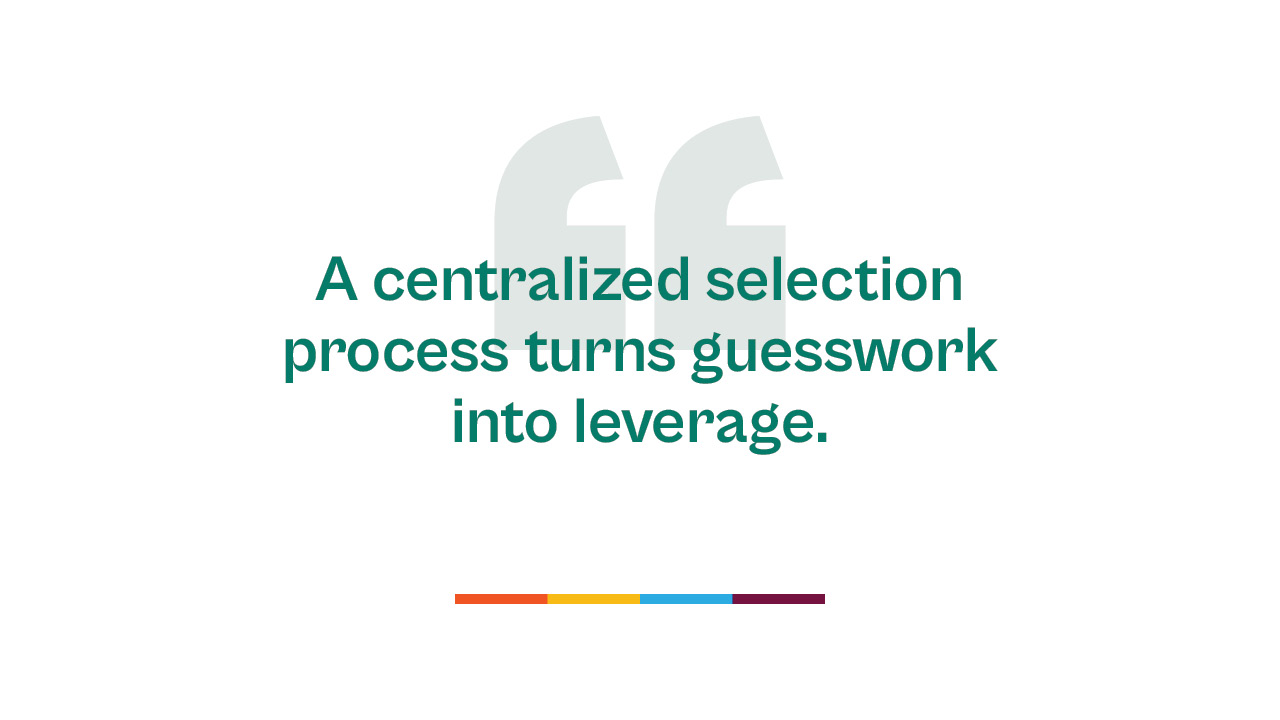
For Platform Teams: The Essential Vendor Selection Framework for Portfolio Companies

Choosing the right vendors is one of the most important and often overlooked ways portfolio companies can save time, reduce costs, and operate more efficiently. But without a clear process, vendor decisions tend to happen in silos.
One portco might pick a vendor based on a cold email. Another might rely on a founder’s personal connection. A third might go with the first option that seems “good enough.”
This kind of inconsistency isn’t just inefficient—it’s risky. It leads to duplicate spending, slower onboarding, poor vendor fit, and missed opportunities to share learnings across the portfolio's startup ecosystem.
That’s where platform professionals and teams really have a golden opportunity to make an impact.
When you provide a clear and successful vendor selection process that’s easy to follow, flexible, and backed by real data, you give your portfolio companies a smarter way to choose the tech stack and services they rely on. It doesn’t have to be overly complex or time-consuming. In fact, the most effective frameworks are often the simplest.
In this guide, we’ll walk through a step-by-step vendor selection process designed specifically for portfolio companies.
You’ll get:
- A repeatable framework you can deploy across your companies
- Tips to make evaluation faster and more consistent
- Downloadable tools like a vendor scorecard template
- Examples of how platform teams add value throughout the process
Whether you’re supporting three portfolio companies or thirty, this framework will help you streamline decision-making, reduce vendor bloat, and give your teams a head start in choosing the right partners.
Defining Business Goals and Vendor Requirements
Before anyone picks a vendor, they need to get clear on what they actually need. Sounds obvious, but this step is often rushed or skipped entirely.
Jumping straight into vendor research without first defining goals almost always produces the same result: mismatched tools, wasted spend, and frustration during implementation.
That’s why a solid vendor selection process for portfolio companies starts here.
1) Start with the Business Goals
Every vendor decision should support a specific business objective. Is the company trying to:
- Scale sales outreach?
- Automate financial reporting?
- Tighten security before a compliance audit?
- Replace a tool that’s too expensive or hard to use?
Encourage your portfolio teams to write down the problem they’re trying to solve in plain language. This keeps the selection focused and helps vendors respond more effectively.
2) Set Clear Success Criteria
Once the goal is clear, define what success looks like. These could be:
- “We want to reduce reporting time by 50%.”
- “We need a vendor who can onboard our team in under two weeks.”
- “We’re looking for SOC 2 compliance and an API that integrates with our CRM.”
These performance indicators will guide the vendor evaluation process and make final decisions easier. They will also make vendor performance monitoring more straightforward further down the road.
3) Must-Haves vs. Nice-to-Haves
Encourage teams to distinguish between core requirements and preferences. For example:
- Must-have: HIPAA compliance for a healthcare tech portco.
- Nice-to-have: Custom branding for the vendor’s dashboard.
These act as vendor selection criteria that can help cut through the noise, limit overbuying, and protect against being swayed by flashy features that don’t support core business needs.
4) Don’t Forget Compliance and Risk
Compliance requirements should be part of the initial scoping, especially in regulated industries like fintech, healthcare, or edtech. Missing this early can lead to deal-killers later in the process. Vet potential vendors on how well they adhere to industry regulations, and analyze their regulatory compliance frameworks.
You can also share a lightweight risk checklist that includes:
- Data privacy needs
- Uptime or SLAs
- Vendor liability insurance
- Security certifications
Pro Platform Tip: Create a one-page intake form or worksheet that each portfolio company can fill out before starting vendor research. This makes it easier to standardize the process across companies—and gives your platform team visibility into what's needed.

Sourcing and Identifying Prospective Vendors
Once your portco has defined its goals and requirements, the next step is finding vendors that actually meet those needs. But with so many options out there, it's easy to get overwhelmed—or settle too quickly.
A strong, strategic sourcing process helps companies avoid shiny-object syndrome and focus on vendors that are truly worth evaluating.
Start with Trusted Sources
The best vendor lists don’t come from a YouTube video. They come from your network. Encourage companies to begin by:
- Asking for internal referrals across the portfolio
- Tapping into founder Slack groups or operator communities
- Looking at which vendors competitors or industry leaders are using
If your platform team maintains an internal vendor directory, that’s gold. Showing which vendors other portcos use and whether they’d recommend them (internal "customer testimonials" of sorts) builds trust and reduces evaluation time.
In the past, these internal lists were simple spreadsheets that became outdated or cumbersome to share and manage. Thankfully, vendor directories can now serve as internal marketplaces where all portfolio companies can access a streamlined, automated portal to vetted vendors. Building tech stacks and securing great vendor deals has never been easier. Learn more here.
What to Look For in a Vendor
Whether you're compiling a shortlist or vetting incoming suggestions, make sure teams are asking the right questions:
- Do they serve companies like us (size, industry, stage)?
- Can they integrate with our existing tools?
- What’s their customer support like?
- Do they have strong references or case studies?
Teams should also look for indicators of stability such as financial support, team size, market experience, and clear pricing.
Evaluate Technical and Operational Fit
Beyond the marketing pitch, help your portcos assess how a vendor fits into daily operations:
- Does their product match the technical skill level of your team?
- Can they meet your security or data requirements?
- Are their onboarding and implementation timelines realistic?
A vendor might look perfect on paper, but if they can’t support a lean startup team or a fast-moving finance department, they're not a good fit. By asking these questions early on, you can spot false matches long before getting entangled in troublesome vendor relationships.
Pro Platform Tip: Consider giving portfolio companies a structured framework for evaluating companies—in particular, a vendor “sourcing scorecard” that includes reputation, fit, integration, and operational readiness. This helps standardize how vendors are assessed across teams, and creates a paper trail for better decisions.
Creating and Managing the RFP Process
Not every vendor decision needs a formal Request for Proposal (RFP). In fact, for many early-stage portfolio companies, an RFP can feel like overkill.
However, when the stakes are high, for instance, with enterprise software, multi-year contracts, or regulated service providers, a simple, structured RFP can prevent a lot of confusion down the line.
When to Use an RFP
Encourage companies to use an RFP when:
- The solution is business-critical or high-cost
- Multiple stakeholders are involved in the decision
- Compliance or security standards must be met
- They want to compare multiple vendors side-by-side
For smaller or fast-moving teams, a lightweight RFP (1-2 page brief) can still offer clarity without slowing things down.
What to Include in an RFP
Whether it’s formal or lightweight, a good RFP should clearly outline:
- The problem the company is trying to solve
- The scope of work and expected outcomes
- Key requirements (technical, functional, regulatory)
- Timeline for selection, onboarding, and go-live
- Evaluation criteria—how proposals will be judged
- Budget expectations (or at least ballpark ranges)
Clarity helps vendors self-select in or out. That saves time on both sides and leads to better proposals.
How to Manage the Process
Support your portcos in setting a simple review structure:
- Assign a lead reviewer internally
- Set a clear deadline for proposals
- Use a shared evaluation rubric or scorecard
- Keep communication centralized (no endless email threads)
Remind teams that the goal isn’t to make the RFP process perfect—it’s to make the selection process clearer and more objective.
Pro Platform Tip: Provide a plug-and-play RFP template that portcos can adapt based on their needs. You can even maintain a shared folder of past RFPs as reference points for other companies joining the portfolio.
Conducting Due Diligence and Comparative Evaluation
Once a shortlist is in place or RFP responses are in, it's time to dig deeper. This is where a structured evaluation process helps turn good guesses into smart decisions.
Due diligence doesn’t have to be overly formal, but it does need to be consistent. Without it, teams can miss red flags or overlook better-fit vendors because someone “liked the demo.”
What Due Diligence Should Cover
Encourage your portfolio companies to focus on three main areas:
1. Financial & Operational Stability
- Is the vendor likely to be around in 12–24 months?
- Do they have the resources to support your scale or complexity?
- Are they transparent about pricing, renewals, or hidden costs?
2. Technical & Functional Fit
- Do they meet security or compliance needs (SOC 2, HIPAA, GDPR)?
- Can they integrate with your existing tools?
- Are there features or limitations that would require workarounds?
3. Customer Experience & Support
- What do existing customers say—especially those similar in size or sector?
- How responsive is their support team?
- Are there knowledge bases, help centers, or onboarding materials available?
A brief 15-minute call with a reference customer can reveal much more than a polished sales deck.
Use a Comparative Scorecard
Without structure, vendor evaluations often default to gut feel or recency bias (whichever vendor pitched last often sounds best). A scorecard gives teams an objective way to evaluate and compare vendors side-by-side.
You might include:
- Alignment with goals (weight: 30%)
- Technical and security fit (20%)
- Pricing and flexibility (15%)
- Customer support (15%)
- Portco team feedback (10%)
- Reference feedback (10%)
The weightings can flex based on what matters most. The key is having something repeatable—so you're not reinventing the process every time.
Pro Platform Tip: Standardize the scorecard across your portfolio. When every team uses the same evaluation format, your platform team can spot patterns, consolidate feedback, and share learnings much faster.
Making the Final Selection: Scoring, Buy-In, and Next Steps
At this point, your team has done the work—defined their needs, sourced vendors, run due diligence, and evaluated options. But the final decision isn’t just about picking the highest-scoring vendor. It’s about selecting the best-fit partner for the company’s goals, timeline, and team.
This is where structure meets judgment.
Use the Scorecard—But Don’t Be Ruled by It
The vendor with the highest score may not always be the right choice. Maybe they’re too rigid on contract terms. Or maybe a slightly lower-scoring vendor has stronger customer support and a faster onboarding path.
The scorecard is a valuable tool that helps guide the decision. But it’s okay to choose differently—just make sure the rationale is documented. That way, if questions come up later, there’s a clear decision trail.
Get the Right Stakeholders Aligned
Make sure all key voices are included before finalizing:
- Functional owner: The person or team who will use the vendor day-to-day
- Finance/legal: To review terms, pricing, risk, and redlines
- Platform team (you): To provide context from other portcos and ensure alignment with broader goals
Encourage companies to have a single final review call or meeting to confirm the choice. Avoid endless email threads or back-and-forth. Once the decision is made, move forward quickly to avoid delays in implementation.
Consider a Pilot if There’s Uncertainty
If the team is still unsure, or if the vendor is a newer player, propose a 30–60 day pilot. Define what success looks like upfront (e.g., onboard 10 users, integrate with X system, achieve Y metric), and use that as a final filter before fully committing.
Capture the "Why"
Have the team briefly document why they chose this vendor. This doesn’t need to be formal. Just a few sentences are sufficient. It becomes incredibly valuable for future evaluations and for other portfolio companies looking at similar tools down the line.
Pro Platform Tip: Create a lightweight vendor decision log that portcos can use to track shortlists, rationale, and key learnings. This becomes a shared asset across the portfolio and reduces repetitive evaluation cycles.
.jpg)
Supporting Strong Onboarding and Performance Tracking
Choosing the right vendor is only half the job. The other half is making sure they actually deliver on what they promised and that your portfolio company is set up to get the most from the partnership.
This is where many teams drop the ball. A good onboarding and tracking plan closes the loop between selection and success.
Setting Vendors Up for Success from Day One
Onboarding doesn’t need to be complicated, but it does need to be clear. Make sure there’s a simple checklist that outlines:
- Who’s responsible for what on each side
- Timelines for implementation, setup, and training
- Any integrations or technical handoffs required
- Success metrics for the first 30–90 days
Encourage vendors to assign a clear point of contact and make sure your portco knows who owns what internally, too. Lack of clarity here leads to delays, missed expectations, and finger-pointing later.
Share a vendor onboarding template with your companies. Even a one-pager makes a big difference.
Track Performance Against Predefined KPIs
Remember those success criteria defined at the start of the process? Now’s the time to use them.
Help companies measure:
- Whether timelines are being met
- If the tool is actually solving the problem it was brought in to solve
- How satisfied users are after onboarding
- Whether vendor support is responsive and helpful
Performance tracking doesn’t have to be formal or time-consuming. Even a 5-minute check-in or monthly score can highlight issues before they turn into bigger problems.
Create a Feedback Loop
Encourage teams to document:
- What went well with onboarding
- What could have gone better
- Whether they’d recommend the vendor to others in the portfolio
This feedback becomes invaluable to other companies looking at similar vendors. Over time, your platform builds a living knowledge base that helps everyone make faster, smarter decisions.
Pro Platform Tip: Use a shared doc or simple form to collect onboarding and performance feedback across portcos. Over time, this becomes an internal “Yelp for vendors” that adds real operational leverage.

The Role of Platform Teams in Making This Work
Most portfolio companies don’t have the time or the muscle power to build a vendor selection process from scratch. That’s why platform teams are so important. They come in and offer structure, resources, and shared visibility.
When platform development is done right, you're not just saving busy founders time. You're helping their companies make smarter, strategic decisions and avoid common traps. This unlocks better outcomes from the vendors they decide to work with.
Be a Guide, Not a Gatekeeper
Your role isn’t to dictate vendor choices. It’s to empower better ones. The most effective platform teams act like internal consultants:
- Helping define needs more clearly
- Sharing vendor benchmarks or success stories
- Offering templates, tools, and a repeatable playbook
This keeps decision-making in the hands of the portcos while leveling up the quality of those decisions.
Create and Maintain Shared Resources
Simple assets like a vendor scorecard, onboarding checklist, or internal review log can create serious value. If your companies all follow a similar path without being forced into it, you’ll see faster cycles, better-fit vendors, and fewer re-evaluations.
The more your team curates insights from across the portfolio, the more useful those assets become. Over time, your vendor knowledge base turns into a true operating advantage.
Build a Feedback Loop Across Companies
Encouraging portfolio companies to share feedback not just with the vendor but with each other is a creative way to reinforce success and build a sense of community amongst your portcos. A lightweight feedback system helps answer:
- Which vendors are delivering real value?
- Where have issues emerged?
- Would this company choose the same vendor again?
That kind of transparency builds trust and accelerates decisions for everyone in the ecosystem.
Pro Platform Tip: Host a quarterly “vendor insights” sync or circulate a short digest with lessons learned, deals negotiated, or feedback received. Even one good insight can save another company weeks of time (or thousands in spend).
How Proven Powers Repeatable, Insight-Driven Vendor Selection
If you're building a repeatable vendor selection process across a growing portfolio, you don’t need to start from scratch—or manage it in spreadsheets.
Proven was built with platform teams in mind. It gives you a central place to streamline vendor selection, share insights, and support companies at every stage of the process—from sourcing to onboarding to performance tracking.
Here’s how it works:
1) Discover Vendors That Are Actually Working
Proven gives portfolio companies visibility into which vendors their peers are already using—and whether those vendors are delivering results. Instead of guessing, your teams get real context: what’s working, for whom, and why.
2) See the Tech Stack of Your Portfolio Peers
For earlier-stage companies, especially first-time founders or lean ops teams, choosing vendors can feel like flying blind. Proven takes out the guesswork by showing them the real tech stacks being used across the portfolio. That context builds confidence, reduces time spent researching, and nudges companies toward vendors that have already been vetted by peers they trust.
It’s like having an internal Yelp, but built specifically for VC and PE-backed companies with real outcomes, not just opinions.
3) Centralize Feedback and Scorecards
With built-in vendor evaluations and performance tracking functionality, Proven helps every company follow a consistent process—without adding overhead. Teams can quickly assess vendors, leave structured reviews, and contribute to a shared knowledge base that compounds in value over time.
4) Reduce Friction, Increase Impact
When portfolio companies have the right vendor tools at their fingertips, they move faster. They avoid repeat mistakes. And they spend more time executing—less time evaluating.
Proven makes it easy for platform teams to scale that support—whether you’re helping five companies or fifty.
5) Unlock Exclusive, Pre-Negotiated Vendor Deals
One of the biggest advantages of using Proven is that your portfolio companies don’t just discover great vendors—they also unlock exclusive deals they couldn’t get on their own.
We’ve pre-negotiated pricing and perks with some of the most trusted providers across key verticals—think AWS, HubSpot, Carta, Vanta, and more. These aren’t generic affiliate discounts. They’re real, preferred-rate deals that can save a single company tens or even hundreds of thousands of dollars annually.
And because every vendor is pre-vetted, platform teams can feel confident offering these options to even their leanest portfolio companies—without needing to negotiate one-off deals every time.
Want to see the impact? Use our savings calculator so your companies can instantly estimate how much they stand to save by tapping into these built-in benefits.
Conclusion
Vendor selection might seem like a small operational detail, but across a portfolio, it adds up fast. That's why having the right framework can help VC firms and their portcos make smarter decisions, avoid costly mistakes, and set themselves up for success in the competitive venture capital industry.
But the journey doesn't end here.
Once vendors have been selected and onboarded, you're now in the business of vendor management, because true cost savings are realized not just at the beginning of the vendor relationship, but throughout its lifetime.
That means you need to artfully balance soft activities like community-building and maintaining active communication across key stakeholders on both sides of the deal, as well as everything from vendor data management to vendor compensation to vendor termination.
Sound like a lot? It is, especially if you're relying on manual processes to keep track of everything. But the right vendor management software can make a significant difference for your VC platform, offering you data analytics, compliance management, quality control tools, and everything else you need for effective supplier management.
Want to learn more about vendor management systems that your platform team can implement to not only get ahead, but stay ahead, in the vendor game?
👉 Estimate Your Portfolio Savings



.png)






